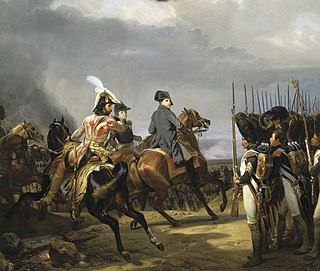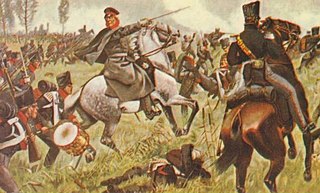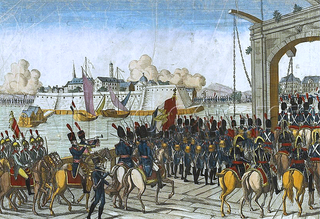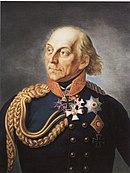
The Battle of Montereau was fought during the War of the Sixth Coalition between an Imperial French army led by Emperor Napoleon and a corps of Austrians and Württembergers commanded by Crown Prince Frederick William of Württemberg. While Napoleon's army mauled an Allied army under Gebhard Leberecht von Blücher, the main Allied army commanded by Karl Philipp, Prince of Schwarzenberg, advanced to a position dangerously close to Paris. Gathering up his outnumbered forces, Napoleon rushed his soldiers south to deal with Schwarzenberg. Hearing of the approach of the French emperor, the Allied commander ordered a withdrawal, but on 17 February saw his rear guards overrun or brushed aside.

The Battle of Montmirail was fought between a French force led by Emperor Napoleon and two Allied corps commanded by Fabian Wilhelm von Osten-Sacken and Ludwig Yorck von Wartenburg. In hard fighting that lasted until evening, French troops including the Imperial Guard defeated Sacken's Russian soldiers and compelled them to retreat to the north. Part of Yorck's Prussian I Corps tried to intervene in the struggle but it was also driven off. The battle occurred near Montmirail, France, during the Six Days Campaign of the Napoleonic Wars. Montmirail is located 51 kilometres (32 mi) east of Meaux.

The twin battles of Jena and Auerstedt were fought on 14 October 1806 on the plateau west of the river Saale in today's Germany, between the forces of Napoleon I of France and Frederick William III of Prussia, at the outset of the War of the Fourth Coalition during the Napoleonic Wars. The defeat suffered by the Prussian Army subjugated the Kingdom of Prussia to the French Empire until the Sixth Coalition was formed in 1813.

The Battle of Château-Thierry saw the Imperial French army commanded by Emperor Napoleon attempt to destroy a Prussian corps led by Ludwig Yorck von Wartenburg and an Imperial Russian corps under Fabian Wilhelm von Osten-Sacken. The two Allied corps managed to escape across the Marne River, but suffered considerably heavier losses than the pursuing French. This action occurred during the Six Days' Campaign, a series of victories that Napoleon won over Prussian Field Marshal Gebhard Leberecht von Blücher's Army of Silesia. Château-Thierry lies about 75 kilometres (47 mi) northeast of Paris.

The Battle of Fère-Champenoise was fought between two Imperial French corps led by Marshals Auguste de Marmont and Édouard Mortier, duc de Trévise and a larger Coalition force composed of cavalry from the Austrian Empire, Kingdom of Prussia, Kingdom of Württemberg, and Russian Empire. Caught by surprise by Field Marshal Karl Philipp, Prince of Schwarzenberg's main Coalition army, the forces under Marmont and Mortier were steadily driven back and finally completely routed by aggressive Allied horsemen and gunners, suffering heavy casualties and the loss of most of their artillery. Two divisions of French National Guards under Michel-Marie Pacthod escorting a nearby convoy were also attacked and wiped out in the Battle of Bannes. The battleground was near the town Fère-Champenoise located 40 kilometres (25 mi) southwest of Châlons-en-Champagne.

The Battle of Wartenburg took place on 3 October 1813 between the French IV Corps commanded by General Henri Gatien Bertrand and the Allied Army of Silesia, principally the I Corps of General Ludwig von Yorck. The battle allowed the Army of Silesia to cross the Elbe, ultimately leading to the Battle of Leipzig.

The Battle of Golymin took place on 26 December 1806 during the War of the Fourth Coalition at Gołymin, Poland, between around 17,000 Russian soldiers with 28 guns under Prince Golitsyn and 38,000 French soldiers under Marshal Murat. The Russian forces disengaged successfully from the superior French forces. The battle took place on the same day as the Battle of Pułtusk.

The Battle of Schleiz took place on 9 October 1806 in Schleiz, Germany between a Prussian-Saxon division under Bogislav Friedrich Emanuel von Tauentzien and a part of Jean-Baptiste Bernadotte's I Corps under the command of Jean-Baptiste Drouet, Comte d'Erlon. It was the first clash of the War of the Fourth Coalition, part of the Napoleonic Wars. As Emperor Napoleon I of France's Grande Armée advanced north through the Franconian Forest it struck the left wing of the armies belonging to the Kingdom of Prussia and the Electorate of Saxony, which were deployed on a long front. Schleiz is located 30 kilometers north of Hof and 145 kilometers southwest of Dresden at the intersection of Routes 2 and 94.

The Battle of Lübeck took place on 6 November 1806 in Lübeck, Germany between soldiers of the Kingdom of Prussia led by Gebhard Leberecht von Blücher, who were retreating from defeat at the Battle of Jena–Auerstedt, and troops of the First French Empire under Marshals Murat, Bernadotte, and Soult, who were pursuing them. In this War of the Fourth Coalition action, the French inflicted a severe defeat on the Prussians, driving them from the neutral city. Lübeck is an old Baltic Sea port approximately 50 kilometres (31 mi) northeast of Hamburg.

In the Battle of Halle on 17 October 1806 a French corps led by Jean-Baptiste Bernadotte fought the Prussian Reserve under Eugene Frederick Henry, Duke of Württemberg. The French defeated their opponents, forcing the Prussians to retreat northeast toward Dessau after suffering heavy losses. The clash occurred in the War of the Fourth Coalition, part of the Napoleonic Wars. The city of Halle is located about 30 kilometers northwest of Leipzig on the Saale River.

In the Capitulation of Erfurt on 16 October 1806, a large body of troops from the Kingdom of Prussia under Lieutenant General the Prince of Orange surrendered to Marshal Joachim Murat of France, at the city of Erfurt. The Prussian soldiers were demoralized by their shattering defeat at the Battle of Jena–Auerstedt on 14 October and unwilling to put up much resistance. The event occurred during the War of the Fourth Coalition, part of the Napoleonic Wars. Erfurt is located on the Gera River about 40 kilometers west of Jena.

Louis-Michel-Antoine, comte Sahuc, was a French army general born 7 January 1755 – died 24 October 1813, joined the French Royal Army and spent 20 years there before fighting in the French Revolutionary Wars. He rose to command a French cavalry regiment and later became a general officer. During the Napoleonic Wars he held important cavalry commands in three of Emperor Napoleon I of France's wars.

In the Battle of Prenzlau or Capitulation of Prenzlau on 28 October 1806 two divisions of French cavalry and some infantry led by Marshal Joachim Murat intercepted a retreating Prussian corps led by Frederick Louis, Prince of Hohenlohe-Ingelfingen. In this action from the War of the Fourth Coalition, Hohenlohe surrendered his entire force to Murat after some fighting and a parley. Prenzlau is located about 90 kilometers north of Berlin in Brandenburg.

The Capitulation of Pasewalk on 29 October 1806 resulted in the surrender of Oberst (Colonel) von Hagen's 4,200 Prussian soldiers to an inferior force of two French light cavalry brigades led by Generals of Brigade Édouard Jean Baptiste Milhaud and Antoine Lasalle. The Prussians were completely demoralized after a two-week-long retreat following their decisive defeat at the Battle of Jena-Auerstedt. Pasewalk is 110 kilometers north of Berlin and about 40 kilometers west of Szczecin (Stettin), Poland.

In the Capitulation of Stettin on 29–30 October 1806, Lieutenant General Friedrich Gisbert Wilhelm von Romberg surrendered the garrison and fortress to a much smaller French light cavalry brigade led by General of Brigade Antoine Lasalle. This event was one of a number of surrenders by demoralized Prussian soldiers to equal or inferior French forces after their disastrous defeat at the Battle of Jena-Auerstedt on 14 October. Stettin, now Szczecin, Poland, is a port city on the Oder River near the Baltic Sea, about 120 kilometres (75 mi) northeast of Berlin.

The order of battle at the Battle of Jena–Auerstedt is listed below. The order of battle includes units from the First French Empire and the Kingdom of Prussia that fought each other in the Battle of Jena-Auerstedt on 14 October 1806. The order of battle may be useful to trace the battles of Schleiz and Saalfeld, which occurred before Jena-Auerstedt, as well as battles and capitulations that happened after 14 October, such as Erfurt, Halle, Prenzlau, Pasewalk, Stettin, Waren-Nossentin, and Lübeck.

In the Battle of Mohrungen on 25 January 1807, most of a First French Empire corps under the leadership of Marshal Jean-Baptiste Bernadotte fought a strong Russian Empire advance guard led by Major General Yevgeni Ivanovich Markov. The French pushed back the main Russian force, but a cavalry raid on the French supply train caused Bernadotte to call off his attacks. After driving off the cavalry, Bernadotte withdrew and the town was occupied by the army of General Levin August, Count von Bennigsen. The fighting took place in and around Morąg in northern Poland, which in 1807 was the East Prussian town of Mohrungen. The action was part of the War of the Fourth Coalition in the Napoleonic Wars.

In the Battle of Guttstadt-Deppen on 5 and 6 June 1807, troops of the Russian Empire led by General Levin August, Count von Bennigsen attacked the First French Empire corps of Marshal Michel Ney. The Russians pressed back their opponents in such a way that saw Ney fight a brilliant rearguard action with his heavily outnumbered forces. During the 6th, Ney successfully disengaged his troops and pulled back to the west side of the Pasłęka (Passarge) River. The action occurred during the War of the Fourth Coalition, part of the Napoleonic Wars. Dobre Miasto (Guttstadt) is on Route 51 about 20 kilometers (12 mi) southwest of Lidzbark Warmiński (Heilsberg) and 24 kilometers (15 mi) north of Olsztyn (Allenstein). The fighting occurred along Route 580 which runs southwest from Guttstadt to Kalisty (Deppen) on the Pasłęka.
The II Cavalry Corps of the Grande Armée was a French military unit that existed during the Napoleonic Wars. It was first formed in December 1806, but only enjoyed a brief existence under Marshal Jean-Baptiste Bessières. The II Cavalry Corps was reconstituted for the invasion of Russia in 1812 and commanded by General Louis-Pierre Montbrun who was killed in battle, as was his successor a few hours later. During the War of the Sixth Coalition, General Horace François Bastien Sébastiani de La Porta led the II Cavalry Corps in 1813, while General Antoine-Louis Decrest de Saint-Germain led the corps in 1814. During the Hundred Days, Emperor Napoleon Bonaparte raised the corps again and entrusted it to General Rémi Joseph Isidore Exelmans.
The VI Cavalry Corps of the Grande Armée was a French military unit that had an ephemeral existence during the Napoleonic Wars. The corps was created on 9 February 1814 and General François Étienne de Kellermann was appointed as its commander. The corps was formed by combining a newly arrived dragoon division from the Spanish front, a second dragoon division, and a light cavalry division made up of hussars and Chasseurs-à-Cheval. The latter two divisions included units from the former III Cavalry Corps. Kellermann led the VI Cavalry Corps at Mormant, Troyes, Bar-sur-Aube, Laubressel, and Saint-Dizier. After Emperor Napoleon Bonaparte abdicated in early April, the corps ceased to exist.
























